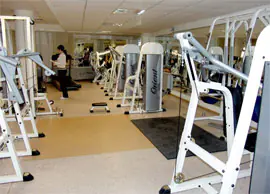In this article we will look at another main place of application of PHOT devices (physical education and health equipment) - production.
Placing health equipment here is no less important than at home or in the yard, if only because we spend, as a rule, nine hours every day at work. Enterprises and organizations must be equipped with a so-called health center - a physical education and health center (PHC).
The funds spent on its creation pay off in abundance: the incidence of illness among workers is reduced (by an average of 5 days per year for each worker), labor productivity is increased, and the likelihood of occupational injuries is reduced.
The creation of such institutions is the direct responsibility of trade union organizations and physical education groups at each enterprise; The administration should not stand aside either. Finally, at each enterprise it is necessary to provide for the possibility of repair and maintenance of the physical labor devices with which the complex or corner is equipped.
The composition of the payroll and its equipment depend on many factors:
- number of employees,
- enterprise profile,
- availability of free space and construction opportunities.
It’s one thing to convert an existing building into a sports complex, breaking down, say, two or three internal partitions and making the necessary repairs. It is quite another to build a new building with the necessary communications and equipment.
When making a choice, you should proceed from the estimated one-time capacity of the health center, which means the number of students using it during one lesson.
Based on the area occupied, any health and fitness center can be classified as:
- small (located in locker rooms, basements or attics, as well as in some auxiliary non-specialized premises of various institutions),
- average (located in standard sports halls measuring 9x18 m, 12x24 m, 15x30 m and in some cases - in prefabricated hangar-warehouse insulated and illuminated rooms),
- big (placed in playpens, recreation areas, in prefabricated rooms connected together).
- from 12—16 to 100 m2 for small ones,
- from 100 m2 to 450-500 m2 - for averages,
- and up to 1200–1400 m2 for large institutions.
In Fig. Figure 1 shows a plan of a health center of a design institute with a workforce of 500–700 people. The steam room, swimming pool and showers are located in the basement; the hall with gymnastics and training equipment occupies the height of the semi-basement and basement; The locker room is equipped with massage devices.
The medical center for miners, designed for 1000 people, is equipped in a completely different way (Fig. 2).
The main health measures are carried out after finishing work, immediately upon exiting the mine. As we can see, the physical training center does not have training and gymnastic physical training devices, since the energy consumption of miners during work is so high that they do not require additional physical activity. But in this FOC, water-air and physiotherapeutic devices are widely represented. These are contrast baths, shower units, sauna, fotarium, inhalator, etc.
Health promotion turns out to be one of the most beneficial activities. This thesis is confirmed by many data.
For several decades now, a physical education and health complex has been operating in Melitopol at a refrigeration engineering plant. Despite the fact that the management decided to install only expensive Octane Fitness equipment. The equipment of the entire complex at that time cost 80 thousand rubles, the annual economic effect (according to the calculations of factory economists) is 600-700 thousand rubles. Thus, improving the health of plant workers brings a huge economic effect at minimal cost.
In the Main Directorate of Passenger Transport of the Moscow City Executive Committee, at one time, an increase in the number of people involved in physical education and sports by 14% led to an increase in the labor activity of drivers by 24%; at the same time, the loss of working time due to illness decreased by 17%. At the Novokuznetsk Aluminum Smelter, workers involved in physical education increased their labor productivity by an average of 12.7%, and the incidence of illness decreased by 9.3%. There are many similar examples...
Post Views: 122


